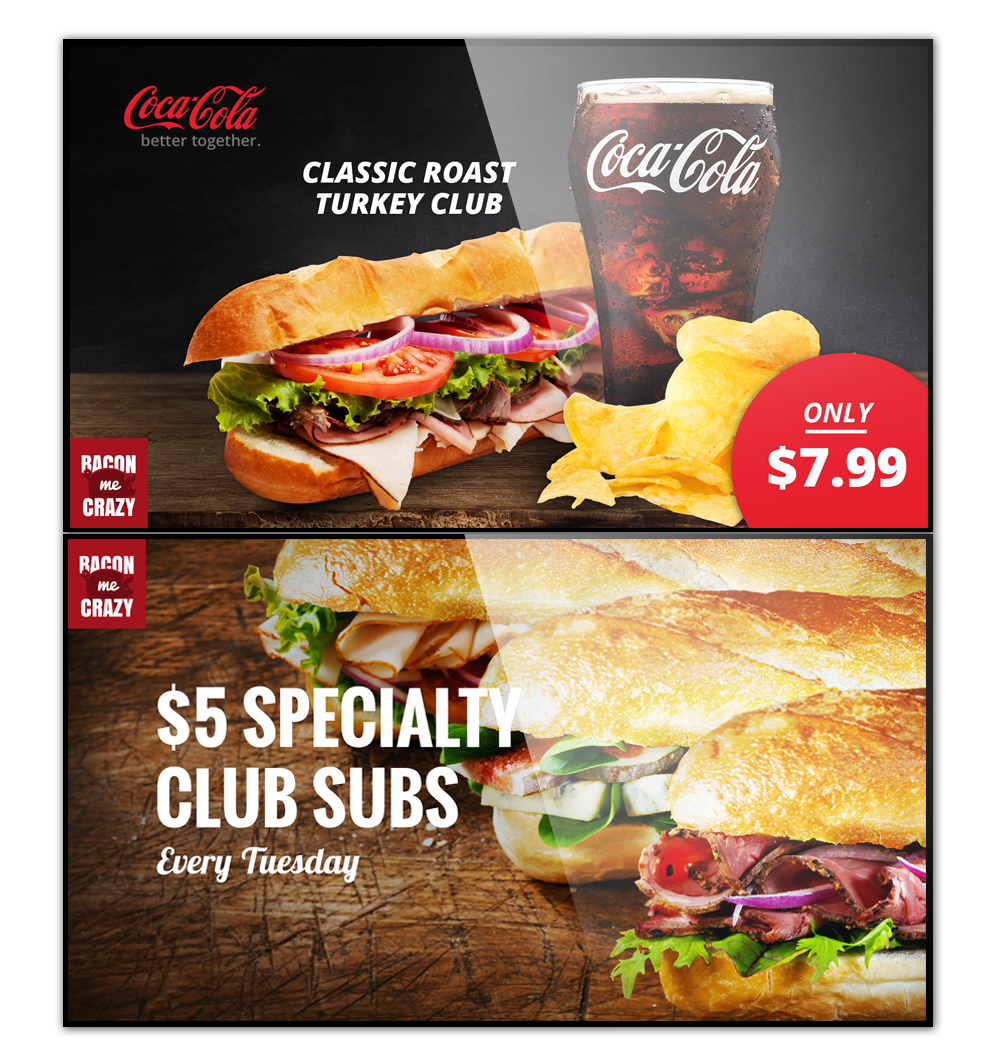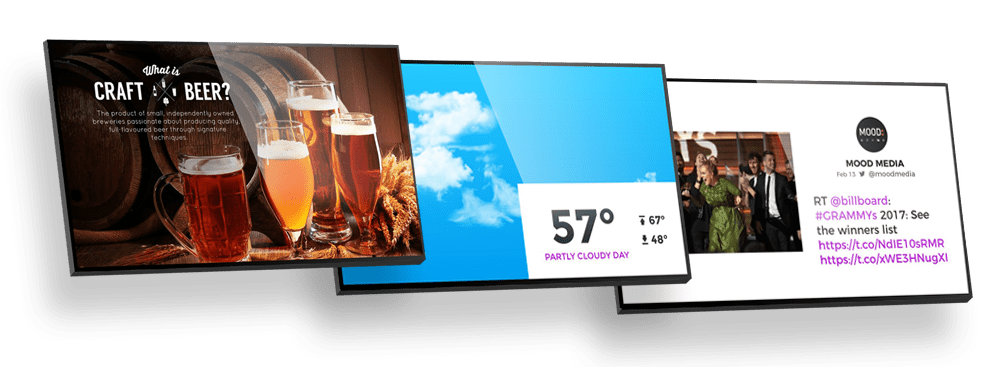6 Steps to Effective Restaurant Digital Signage
When it comes to food service industries, restaurant digital signage isn’t just for QSR and Fast Casual.
In fact, full service restaurants of all types and sizes are also using this technology to enhance the dining experience and increase revenue in big ways.
Restaurant digital signage creates these types of results because it appeals to our natural attraction to screens. However, just because you have screens and content up on the walls doesn’t mean you’re going to truly win your guests’ attention. The restaurants that are having the most success with digital signage live by this golden rule:
PLAY THE RIGHT CONTENT IN THE RIGHT PLACE AT THE RIGHT TIME
We’ll break down the six most important steps you’ll need to take to do just that.
#1: Know Your Goals.
Of course, the primary goals of restaurant signage are to drive sales and enhance the dining experience, but there are several smaller objectives that will help you achieve these larger goals. To truly maximize your investment in this technology, you’ll need to specifically define a content strategy that accounts for these smaller objectives. Common examples include:
- Highlighting menu items and daily specials
- Drawing foot traffic
- Promoting special events and sister restaurants
- Highlighting staff, frequent guests and community involvement
- Supplementing interior décor and ambiance, creating a “wow” factor
- Supplementing live TV/entertainment
- Highlighting cleanliness efforts and safety best practices
#2: Know Where It Goes.
Screen placement is essential to maximizing the success of your restaurant digital signage, and your goals should dictate where your screens go – not the other way around.
For example, if you’re looking to draw foot traffic, your screens need to be external facing and placed in the windows. This sounds obvious, but it’s still important to emphasize.

If you want to promote specific menu items while guests are in the restaurant, your screens should be in places that most, if not all of your guests can see. Consider the front entrance, near the bar and on the way to the restrooms. If you’re simply looking to enhance ambiance, mounting the screens in subtle, yet noticeable places in the host area or around the perimeter of your space will do (e.g., a video wall at the back of the dining room).
If you already have screens in place, you may want to consider remounting them in order to best fulfill the goals you’re trying to achieve. We highly recommend consulting a digital signage expert to determine the best possible screen placement.
#3: Set A Realistic Budget.
There isn’t a typical budget for restaurant digital signage, so you’re going to need to do some additional research and get quotes. You’ll need to factor in the costs of:
- The visual media player (a.k.a., digital signage hardware). It’s either purchased at a flat rate or leased for a monthly fee.
- The digital signage software that manages the content displayed on the screens. Software is typically packaged into a monthly service fee.
- Content development and management services (if needed). If you don’t already have images and other visual assets, some providers can create content for you. Some can even manage the content on your behalf.
- Commercial-grade screens* these come in all shapes and sizes from numerous brands with multiple features.
Do your homework here, as this tends to be the largest expense, but it’s not an area to cut too many corners.
*Some quick notes on screens – Even though the types of screens you use at home can work with digital signage, they’re not ideal for use in your restaurant a number of reasons. For starters, commercial-grade screens have protective bezels that enable them to withstand excessive heat. Additionally, the HD screens you use at home are only designed to work about 4-6 hours a day, while commercial-grade screens are made to run continuously. They’re also less prone to “burn in,” a condition that frequently happens with consumer screens. Finally, commercial-grade screens have higher display ratios, resulting in a better picture.
In order to get the best bang for your buck, you’ll want to go with a single provider that can offer all of these components. You won’t have to work with several vendors in order to support one solution, enabling you to save time and money in the long run. A credible and trustworthy digital signage provider should also be able to give you an idea of a realistic budget.
#4: Start Small, Then Scale.
If you have multiple locations and you’re new to the game, it’s a good idea to initially implement your digital signage at one or two restaurants before rolling it out to the rest. Doing so will give you a chance to test and fine-tune your digital signage strategy while minimizing your upfront investment.
If you only have one location, try implementing a few screens at first and measure their effectiveness over the course of a few months. Experiment with different types of content and get a good feel for what works with your clientele and what doesn’t. The testing you do in the beginning will pay dividends down the line.
#5: Plan On Dayparting.
Unless you’re only open for one meal a day, you should employ different content strategies for different times of day in order to ensure that your content is relevant. Make sure that you’re promoting your breakfast specials in the morning, your lunch menu in the afternoon, etc.
However, that’s not to say that you shouldn’t promote your dinner menu at lunch or breakfast time at all. For example, using a board near the entrance to feature your lunch menu or dinner entrees is a great way to drive awareness on all that you have to offer.

#6: Update Your Content Frequently.
Again, your content needs to be as relevant as possible, with respect to both time and audience. For example, if you’re still promoting “Summer Special – Surf N’ Turf” in November, you’re going to lose credibility with your guests, and your lack of attention to detail can reflect poorly on other aspects of your restaurant.
Furthermore, if you’re promoting the same thing week after week, your regulars will eventually begin to ignore your digital signage. Try creating multiple layouts or versions of the same message in different looks. You can also create a large library of “evergreen” content that can be swapped in and out often. Even the smallest changes, such as changing a background or the color of text will keep your audience engaged.
As a rule of thumb, aim to update your digital signage content at least once every 4 weeks, with major changes applied every season.
We hope this article has helped shed light on where to start with your digital signage strategy. Contact our digital signage experts today to learn more, and they’ll be happy to answer any questions you have.
Lastly, if your business has a regional, national or global footprint, be sure to download “Digital Signage for National and Global Brands.” This free eBook goes into greater detail on many of the topics covered here. It also provides invaluable insights for those looking to implement digital signage at scale.
CONNECT WITH US
Contact us today and elevate the customer experience at your business.
"*" indicates required fields
